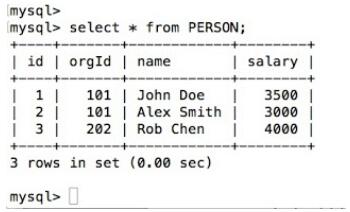Apache Ignite:如何从持久化存储中读取数据
原文: Apache Ignite: How to Read Data From Persistent Store
作者: Dmitriy Setrakyan
责编: 孙思,关注数据库领域,寻求报道或者投稿请发邮件sunsi@csdn.net,另有「CSDN 高级数据库技术群」,内有诸多知名互联网公司的大牛,欢迎加微信sunlovesi申请入群,备注姓名+公司+职位。
数据可以直接从任何持久存储区加载到Apache Ignite缓存。这个例子展示了如何从一个MySQL数据库加载数据到另一个Ignite分布式缓存。在这里,假设你已经在你的系统上安装了Apache Ignite。如果没有,你可以先通过本教程学习下。
1.Sample PERSON Table
首先,这是我数据库中PERSON的数据:

2.模型
这是一个Person.java类对应数据库中PERSON表的例子。
public class Person { private long id; private long orgId; private String name; private int salary; // Constructor … // Getter and Setter methods … }3.Maven Dependency
我已在我的项目 pom.xml 中指定了以下依赖项 :
<dependency> <groupid>org.apache.ignite</groupid> <artifactid>ignite-core</artifactid> <version>1.5.0.final</version> </dependency> <dependency> <groupid>org.apache.ignite</groupid> <artifactid>ignite-spring</artifactid> <version>1.5.0.final</version> </dependency> <dependency> <groupid>mysql</groupid> <artifactid>mysql-connector-java</artifactid> <version>5.1.6</version> </dependency>4.Read-Through配置
从数据库中加载数据,你需要启用 read-through 模式和设置CacheConfiguration的cacheStoreFactory属性。你可以在pring XML配置文件或程序中设置这些值。
<bean class="org.springframework.jdbc.datasource.DriverManagerDataSource" id="dataSource"> <property name="driverClassName" value="com.mysql.jdbc.Driver"></property> <property name="url" value="jdbc:mysql://localhost:3306/mydbname"></property> <property name="username" value="username"></property> <property name="password" value="passwd"></property> </bean> <bean class="org.apache.ignite.configuration.IgniteConfiguration" id="ignite.cfg"> <property name="cacheConfiguration"> <list> <bean class="org.apache.ignite.configuration.CacheConfiguration"> <property name="name" value="personCache"></property> <!-- Enable readThrough--> <property name="readThrough" value="true"></property> <property name="writeThrough" value="true"></property> <!-- Set cacheStoreFactory--> <property name="cacheStoreFactory"> <bean class="javax.cache.configuration.FactoryBuilder" factory-method="factoryOf"> <constructor-arg value="myexamples.store.PersonStore"></constructor-arg> </bean> </property> <property name="queryEntities"> <list> <bean class="org.apache.ignite.cache.QueryEntity"> <property name="keyType" value="java.lang.Long"></property> <property name="valueType" value="ignite.myexamples.model.Person"></property> <property name="fields"> <map> <entry key="id" value="java.lang.Long"></entry> <entry key="name" value="java.lang.String"></entry> <entry key="orgId" value="java.lang.Long"></entry> <entry key="salary" value="java.lang.Integer"></entry> </map> </property> </bean> </list> </property> </bean> </list> </property> <property name="peerClassLoadingEnabled" value="true"></property> <!-- Other Ignite configurations--> ... </bean>5.实现CacheStore
现在我们有我们的模型,Maven依赖关系和缓存已配置到位,那么,现在是时候来实现存储。若从数据库加载数据,应实现CacheStore接口的 loadCache()和 load()的方法。
public class PersonStore implements CacheStore<Long, Person> { @SpringResource(resourceName = "dataSource") private DataSource dataSource; // This method is called whenever IgniteCache.loadCache() method is called. @Override public void loadCache(IgniteBiInClosure<Long, Person> clo, @Nullable Object... objects) throws CacheLoaderException { System.out.println(">> Loading cache from store..."); try (Connection conn = dataSource.getConnection()) { try (PreparedStatement st = conn.prepareStatement("select * from PERSON")) { try (ResultSet rs = st.executeQuery()) { while (rs.next()) { Person person = new Person(rs.getLong(1), rs.getLong(2), rs.getString(3), rs.getInt(4)); clo.apply(person.getId(), person); } } } } catch (SQLException e) { throw new CacheLoaderException("Failed to load values from cache store.", e); } } // This method is called whenever IgniteCache.get() method is called. @Override public Person load(Long key) throws CacheLoaderException { System.out.println(">> Loading person from store..."); try (Connection conn = dataSource.getConnection()) { try (PreparedStatement st = conn.prepareStatement("select * from PERSON where id = ?")) { st.setString(1, key.toString()); ResultSet rs = st.executeQuery(); return rs.next() ? new Person(rs.getLong(1), rs.getLong(2), rs.getString(3), rs.getInt(4)) : null; } } catch (SQLException e) { throw new CacheLoaderException("Failed to load values from cache store.", e); } } // Other CacheStore method implementations. … }为了方便起见,Ignite还为用户提供了一些具有默认实现CacheStore方法的CacheStoreAdapter类—— loadAll()、writeAll()和deleteAll()。
6.加载缓存
这是一个PersonStoreExample.java类调用IgniteCache.loadCache()方法,在内部将调用CacheStore.loadCache()方法的示例(在上一步中我们实现了)。
public class PersonStoreExample { public static void main(String[] args) throws IgniteException { Ignition.setClientMode(true); try (Ignite ignite = Ignition.start("config/cluster-config.xml")) { try (IgniteCache<Long, Person> cache = ignite.getOrCreateCache("personCache")) { // Load cache with data from the database. cache.loadCache(null); // Execute query on cache. QueryCursor<List<?>> cursor = cache.query(new SqlFieldsQuery( "select id, name from Person")); System.out.println(cursor.getAll()); } } } }7.开始Ignite集群
从命令shell中,使用下面的命令,自己安装Ignite文件夹并启动服务器节点:
$ bin/ignite.sh <path-to-Spring-XML-configuration-file>确保personstore.java是在类路径中Ignite。这样做,你可以设置USER_LIBS环境变量,或将项目jar放入Ignite安装的libs文件夹中。
8.输出
从你的IDE,运行PersonStoreExample.java。

更多的信息和文档,用户可以访问 ApacheIgnite网站 。
- 本文标签: Property cat IDE REST java src struct map Select Connection tab Word 互联网 数据 list spring lib shell sql App dataSource ssl http 数据库 UI value mysql client pom cache 集群 CTO Java类 服务器 core tar 配置 key build maven bean 网站 SDN final apache entity 安装 XML example db
- 版权声明: 本文为互联网转载文章,出处已在文章中说明(部分除外)。如果侵权,请联系本站长删除,谢谢。
- 本文海报: 生成海报一 生成海报二











![[HBLOG]公众号](https://www.liuhaihua.cn/img/qrcode_gzh.jpg)

